The Real Hunger Games: A Battle Royale In The Grocery Aisles
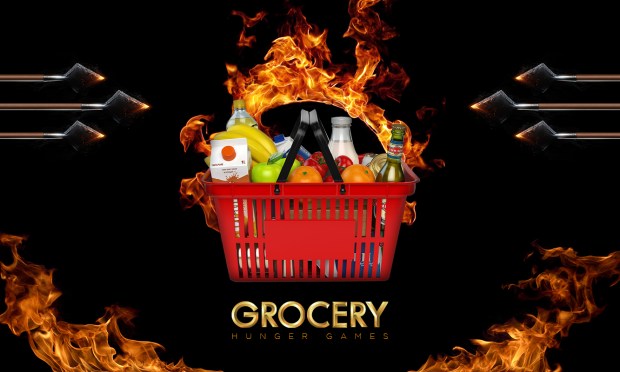
Ten years ago, one-time television writer Susan Collins published the first installment in her post-apocalyptic dystopian young adult novel trilogy, “The Hunger Games.”
(Ten-year-old spoilers to follow…)
For those who somehow missed the book, the movies and the brief but intense mania that surrounded the series a few years ago, “The Hunger Games” trilogy is a much more fun read, which the words “post-apocalyptic” and “dystopian” might infer.
The easiest possible summary is that in a post-apocalyptic future, the United States has become the Kingdom of Panem, which consists of a rich, technologically vibrant capital city ringed by 12 impoverished agrarian or industrial districts that are exploited for their resources by wealthy residents of the capitol.
And, because at some point in the past, the districts had rebelled against that rather unfair distribution of wealth and failed to overthrow the government, every year each of the 12 districts sends two teenagers to the capitol via a lottery to compete in the annual Hunger Games. (There was once a 13th district, but it doesn’t send anyone because it was destroyed in the pre-story rebellion.)
Once the 24 competitors (tributes) get to the games, they then battle to the death for a national audience that is required by law to watch the games. Literally, to the death – at the end of the Hunger Games, one tribute is left standing and goes on to a life of comfort and wealth. The other 23 contestants die in various gruesome and creative ways for the audience watching at home.
There’s also a love triangle, political intrigue and a lot of extremely detailed descriptions of beautiful clothes and sumptuous meals.
And, as we were rereading “The Hunger Games” in celebration of its 10th anniversary, particularly all of the food parts, we got to thinking about the grocery landscape in the U.S. as of 2018. We couldn’t help but start to think about the Hunger Games. While it might be a bit of an exaggeration to call the fight for grocery supremacy in the U.S. a battle royale to the death – it’s really only a small one.
No one is going to die over this (probably), but billions are going to be invested – and at the end, at least some of the districts may well be totally obliterated.
District 1: Amazon/Whole Foods
Amazon/Whole Foods is the newest district in the Grocery Hunger games – the combination of two smaller efforts (Amazon Fresh and Whole Foods Market) made possible by Amazon’s $13.7 billion acquisition about a year ago. And it’s been a very big year – big enough, in fact, that the players in grocery and the investors who watch the segment are looking at Amazon to set the pace of the race, despite the fact that its total offering is relatively new.
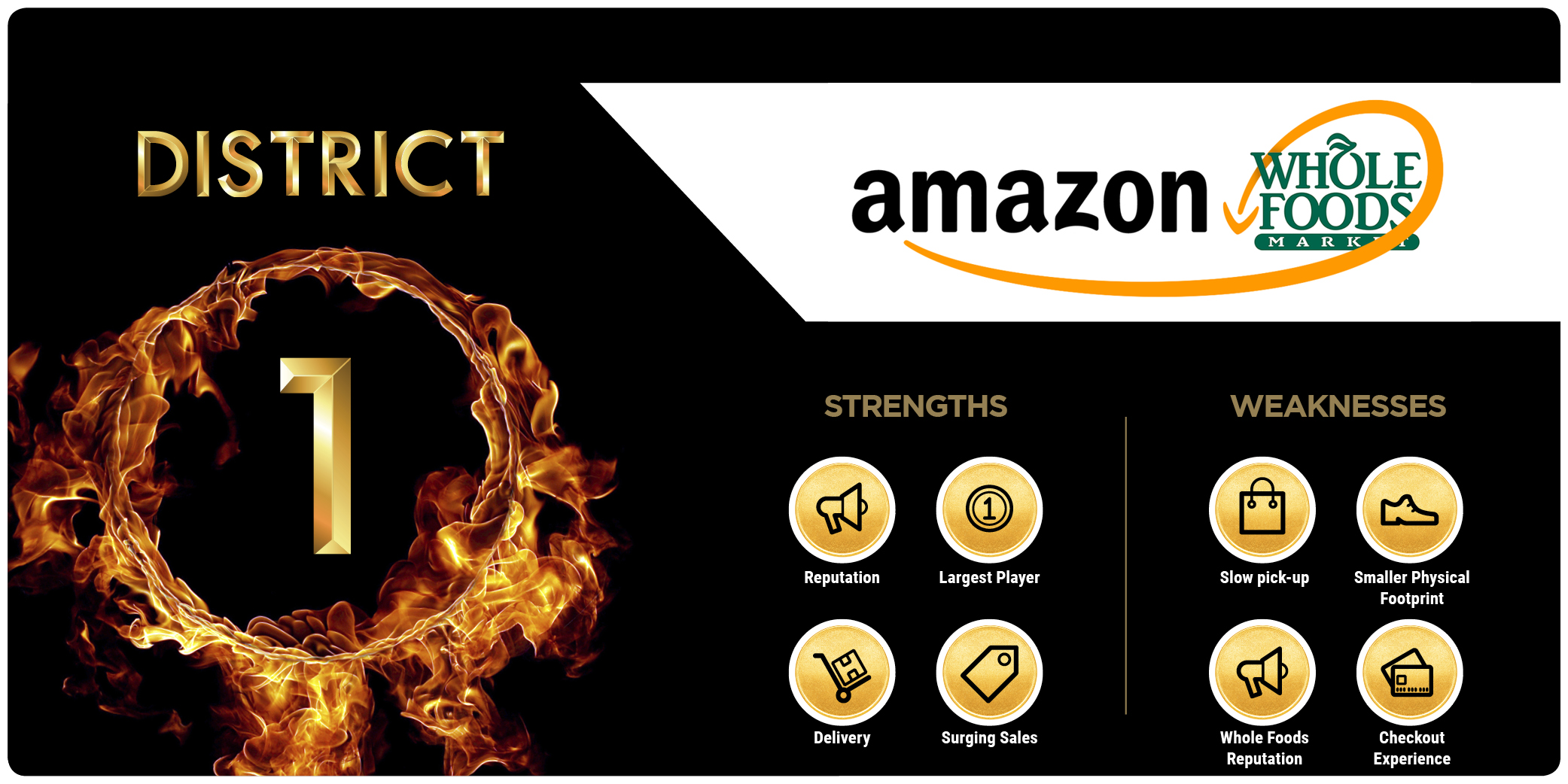
Strengths
- Reputation: Both Whole Foods and Amazon have a strong reputation for customer service and quality. According to the Harris Poll, Amazon is the most trusted U.S. retailer.
- Largest eCommerce grocery player: Amazon has 18 percent of U.S. online grocery sales since 2017, the largest share of any single retailer and double its closest competitor. Granted, it’s still a tiny sub-5 percent share, but it’s growing, and Amazon is the lead horse with lots of digital savvy and logistics to leverage.
- Grocery delivery: It’s now live in 24 markets in the U.S. and with more planned. Prime members can get free grocery delivery within two hours, or pay $7.99 for service within one hour.
- Surging sales: Amazon saw grocery sales rise by 40 percent in Q2 2018.
Special Weapons
- Amazon Prime: Serves as the loyalty program for Whole Foods, allows Amazon to push discounts and special orders. Boasts 100 million members that skew affluent and spend more.
- Amazon Pay: The payment method for Amazon Prime, which makes payment at checkout a breeze. The automatic application of coupons and discounts takes the pain out of coupon clipping. When linked to the Amazon Chase card, the cash-back makes the experience even more of a win, in addition to serving as a natural pull toward card/brand share shift.
- Amazon Alexa: As of August 2018, the digital assistant is now able to add Prime Now order items to a Whole Foods cart, with same-day delivery guaranteed within two hours.
- Private-label brands: A leader in private-label brands in key categories before the Whole Foods acquisition, Amazon now has the ability to push private-label brands and put the squeeze on the supply chain to improve already thin grocery margins. And since we know that shoppers increasingly favor long-tail products that may even cost a bit more, there could be more advantages that accrue.
- Acceptance of SNAP/EBT online: Amazon is one of several retailers, including Walmart, selected by the USDA to pilot the use of SNAP/EBT online to buy groceries. Amazon also offers discounts on Prime memberships to SNAP recipients. Since Walmart serves proportionally more of those shoppers than any other grocer, that could become an important driver of Amazon grocery sales moving forward.
Weaknesses
- Slow on curbside pick-up: As of August 2018, Amazon is rolling out pilots in its first two markets of Sacramento and Virginia Beach.
- Smaller physical footprint: As of 2018, there are about 479 Whole Foods locations.
- Reputation of Whole Foods as Whole Paycheck: This is something that the retailer is trying to shake with discounts and promos linked to Amazon Pay/Prime.
- Inconsistent Amazon Pay checkout experience: Some stores have fully integrated, some have not – meaning that showing a QR only deducts coupons and discounts, and shoppers still have to pull out plastic to pay.
District 2: Walmart
Currently the biggest district in the grocery Hunger Games as the largest grocery retailer in the United States, with more than 50 percent of its sales coming from grocery, Walmart is highly covetous of its crown – and highly dedicated to keeping it.
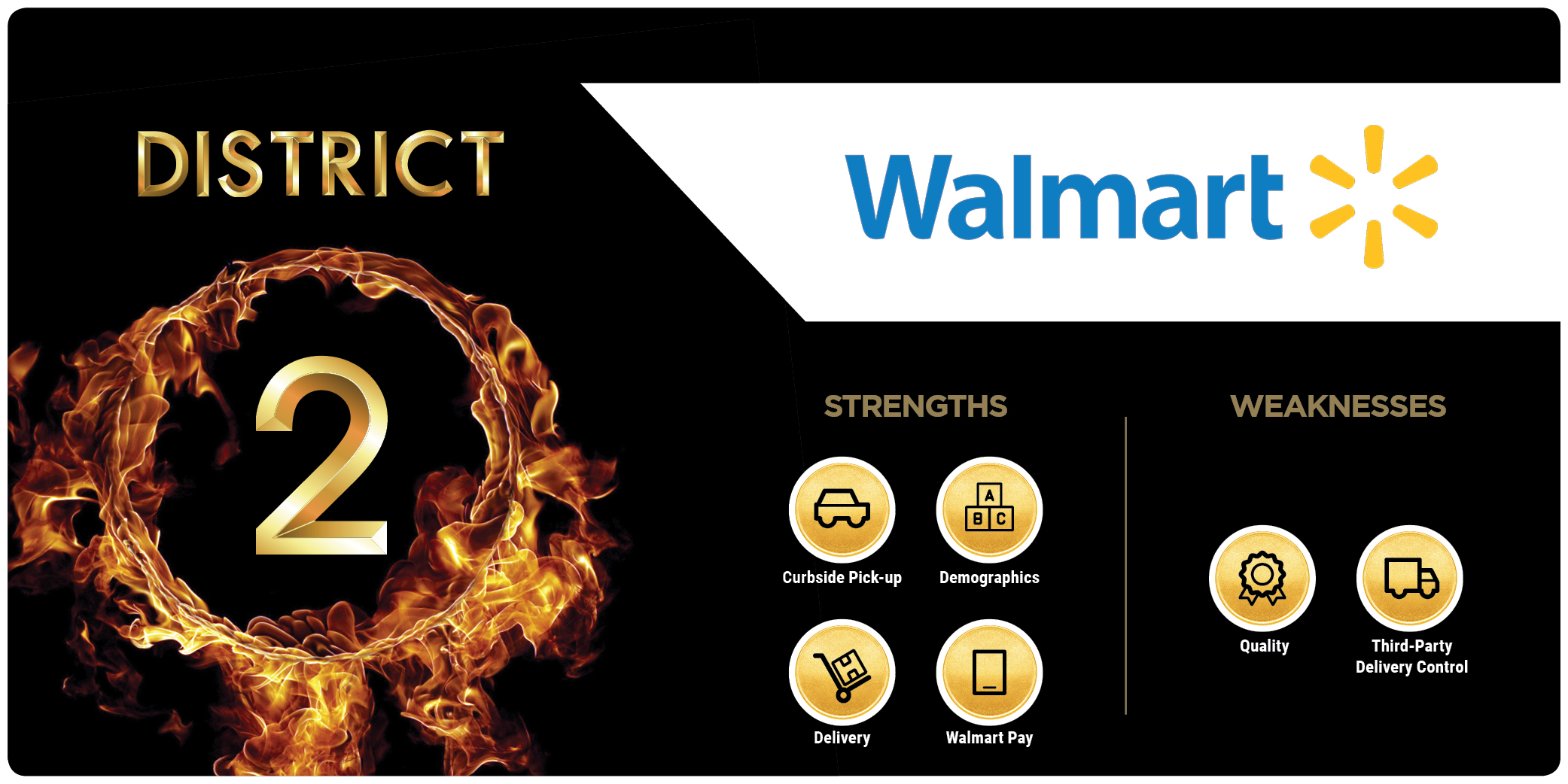
Strengths
- Curbside pick-up: It’s a real hit. There are currently 1,800 Walmart stores that support curbside pick-up – twice as many as in 2017. And Walmart’s not finished expanding for the year yet – by the end of 2018, the retailer plans to offer the service at 1,200 locations.
- Expanding delivery: Walmart has also expanded its online grocery delivery options with transportation partners like Postmates and DoorDash. The goal is to cover 40 percent of the U.S. population with grocery delivery service by year’s end.
- Expanding demographics: While once considered a brand of very value-conscious or lower-class shoppers, with its addition of organic and specialty items, Walmart is now for everyone: 78 percent of consumers report having ordered something online from the retailer in the last three months.
- Walmart Pay: The mobile payments app has captured more in-store share than Apple Pay, and is among the stickiest mobile payments app that customers carry. Walmart Pay checks shoppers in at the terminal, and when they are finished, the phone and app can be put away to focus on getting groceries in the car.
Secret Weapons
- Scale: Walmart controls 25 percent of the grocery market in the United States. Counting Sam’s Club, it has more than five thousand locations, and 90 percent of Americans live within 10 minutes of a Walmart location. 100 million people shop there every week. No other retailer can even get close to matching its scale.
- Click-and-collect dominance: According to Packaged Facts, among click-and-collect consumers, about 42 percent identified Walmart as the pickup location for their last order — three times the amount that cited Target, which came in second.
Weaknesses
- Quality: Walmart has expanded its customer base with a wider offering and greater range of grocery offerings – but produce, meats and other fresh products are consistently ranked below that of competing grocery operators.
- Third-party delivery control: Walmart doesn’t run its own grocery delivery, working instead through third-party partners. Cracking logistics is critical for Walmart to compete head-to-head with Amazon on this front.
District 3: Ahold Delhaize
Netherlands-based Ahold Delhaize is one of the larger foreign players in the U.S. grocery market, with 6,500 locations spread across 11 countries in the supermarket and pharmacy vertical. In the U.S., it is the brand behind Food Lion, Stop & Shop, Hannaford, Giant, Martin’s, bfresh and the grocery delivery service Peapod.
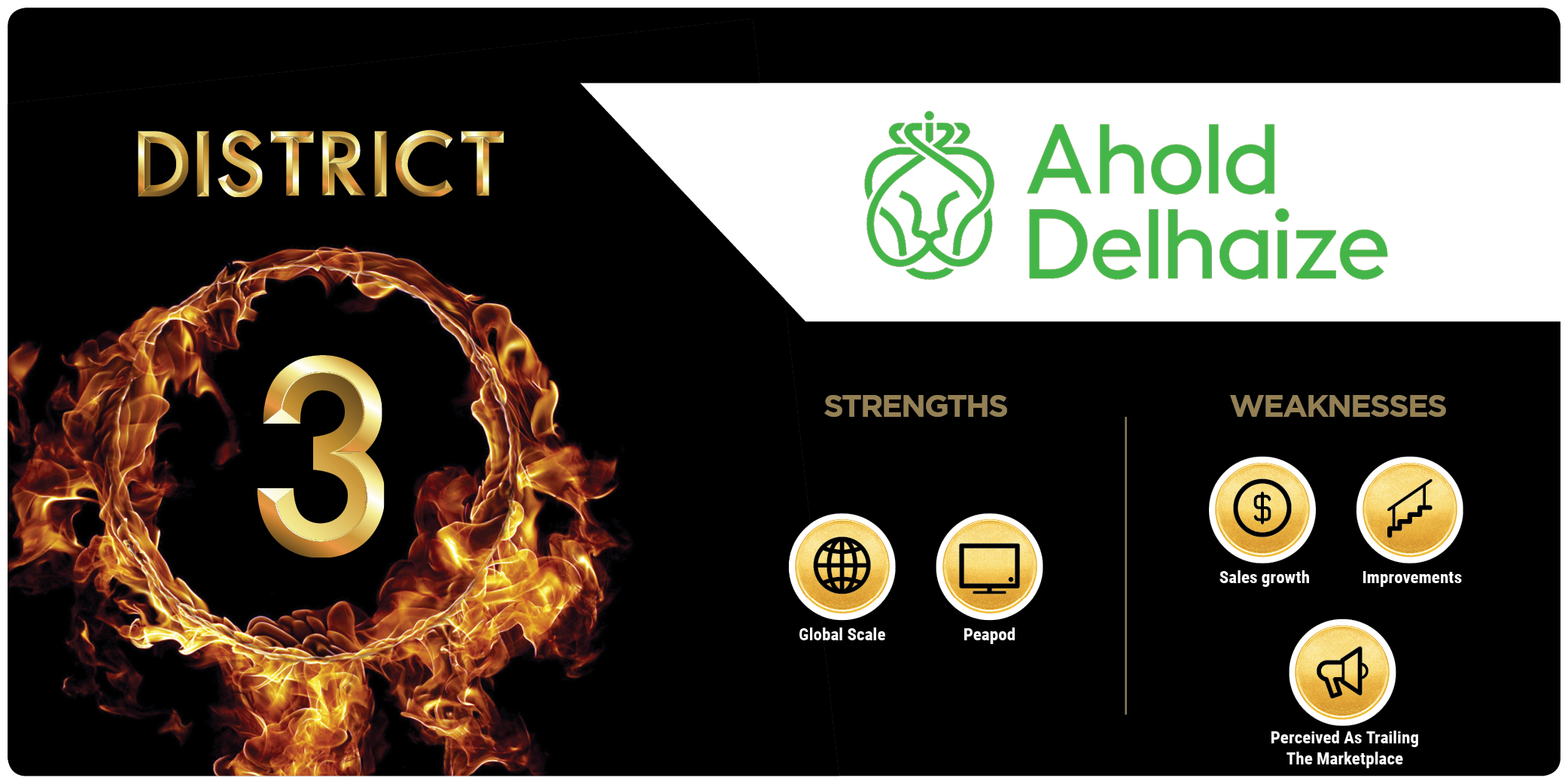
Strengths
- Global scale: Despite weakness in U.S. sales for the last few quarters, the international grocery retailer continues to report solid growth thanks to its stronger performance in other global markets.
- Peapod: Founded in 1989, and the only grocery delivery survivor when the dot-com bubble burst at the turn of the century, Peapod is far and away the most experienced player in grocery delivery in the U.S., with 30 years in the game.
Secret Weapon
- Peapod digital labs: Announced during Ahold Delhaize’s last earnings call, the new research center aims to redevelop its U.S. online strategy.
Weaknesses
- Weak online sales growth: Online sales were only up 8 percent year-on-year, and digital sales represent only 2 percent of the brand’s total revenue.
- Expensive improvements needed: Analysts estimate that Ahold Delhaize needs to invest at least $1.6 billion to catch up to the market.
- Perceived as trailing the marketplace: According to analysts, the retailer’s pricing, store standards, delivery and customer satisfaction are all “significantly” behind its peers.
District 4: Target
The next largest of the big box stores in the grocery game, Target boasts over 1,800 locations in the U.S. Grocery is very important to Target’s bottom line, representing about 20 percent of its annual revenue. After losing a step and seeing sales fall in 2017, Target has doubled down on grocery, investing in upgrades in its services, store revamping and deep discounting on prices.
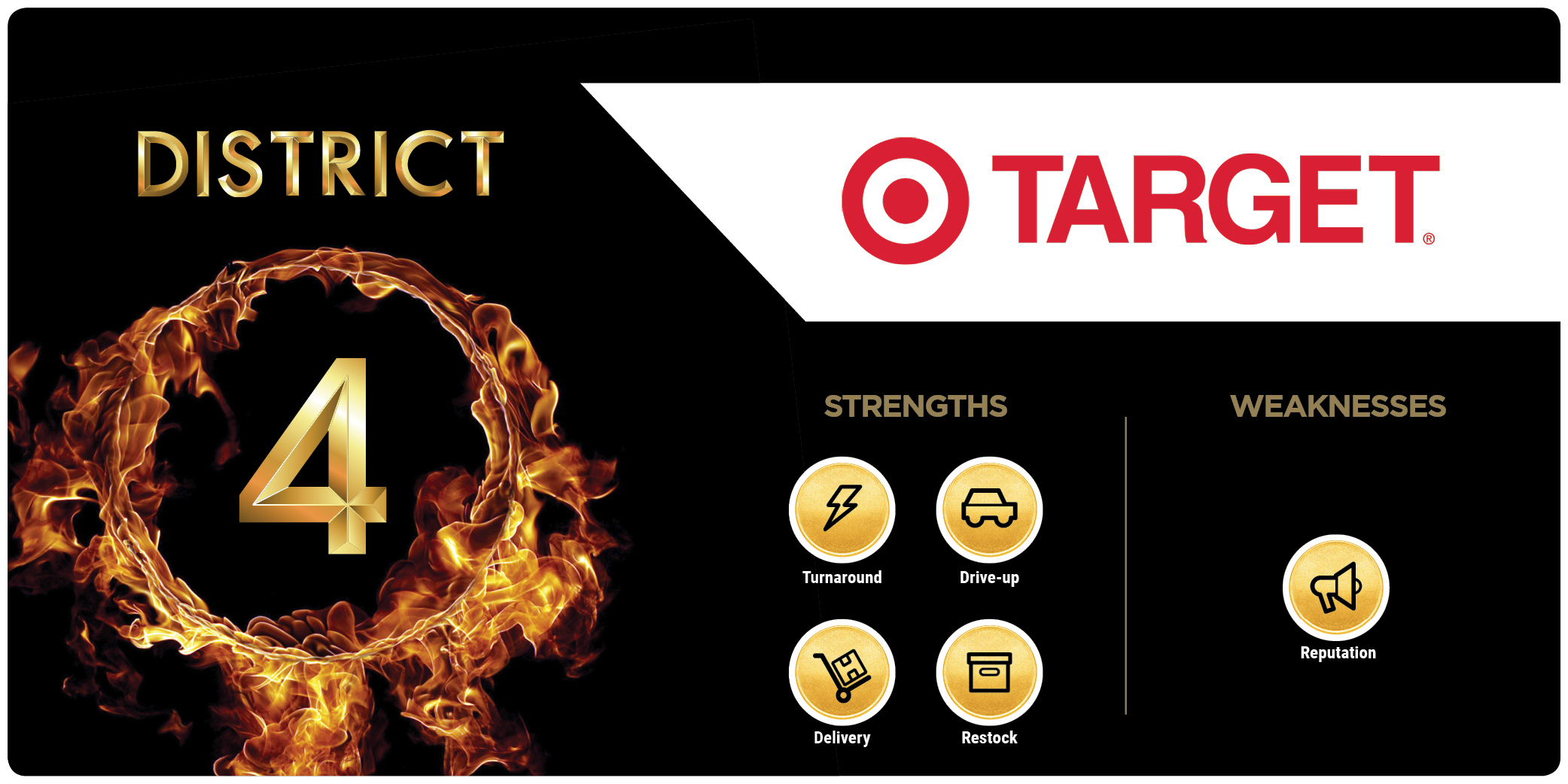
Strengths
- Recent turnaround: Target recently reported online traffic up by 42 percent year-on-year, and same-store sales up 6.5 percent – a pick-up credited to increased grocery strength. The retailer also reported being on track to complete 1,100 store remodels in the next two years.
- Same-day delivery: This offering is now available at more than 1,100 stores in 160 markets.
- Drive-up: Target’s version of curbside pick-up is now available at 800 stores in 25 states.
- Restock: Target’s answer to Prime Pantry allows shoppers to build boxes full of everyday items like paper towels and dish soap, paying a flat shipping rate. Purchases made on the Target REDcard ship for free.
Secret Weapon
- Shipt: The grocery delivery service purchased by Target for $550 million has put the retailer on track to offer free (with a $110 annual Shipt membership) grocery delivery to 65 percent of all U.S. households by the 2018 holiday season.
Weaknesses
- Product reputation: According to analysts, Target is to have a weaker fresh food offering than its peers, both in terms of quality and variety.
District 5: Aldi
Located in 10 countries with over 10,000 locations globally, Aldi has carved a prominent and larger than expected niche into the U.S. grocery landscape. It’s a unique grocery experience in any regard, but one that has won a fairly dedicated and loyal fanbase.
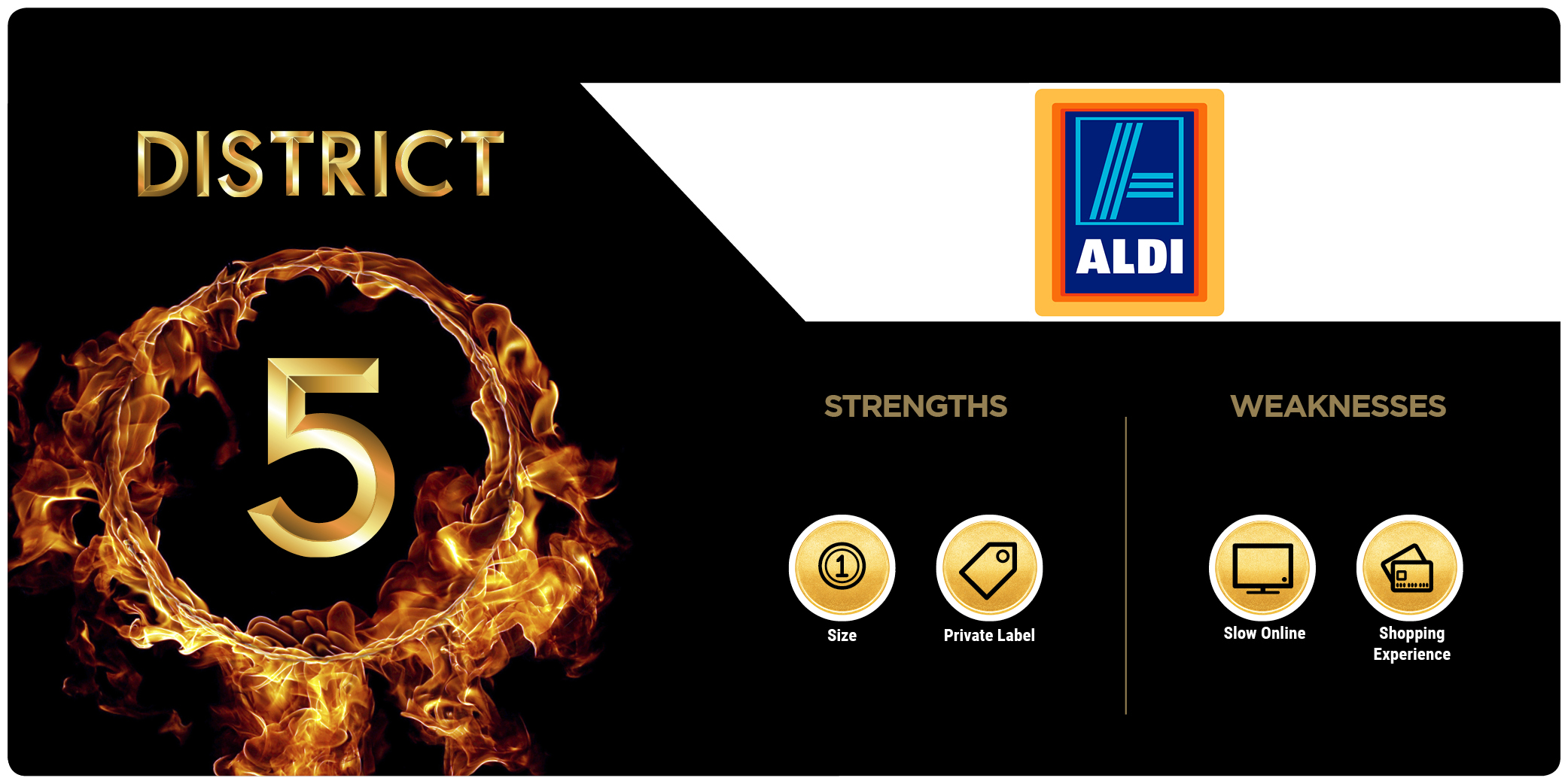
Strengths
- Size: Aldi has a larger footprint in the U.S. than most think, with 1,750 locations in the country and future growth planned.
- Private-label brands: Though unlike their cousins in District 6 (Trader Joe’s), Aldi does carry some large, national name brands – but those brands are sprinkled (and by some descriptions, buried) among Aldi’s wide array of private-label goods. Aldi’s goods are well-regarded among enthusiasts as being a bit unusual, but of nearly universally high quality. Particularly popular are the Mama Cozzi line of pizzas.
Secret Weapon
- Price: Aldi, because it largely trades in private-label brands, tends to be significantly cheaper than its grocery competitors. The store claims that customers save, on average, 42 percent shopping there. And though that figure has been called out as a bit high, as it is a comparison of buying Aldi’s in-house brands against buying name brands at other grocers, even stacked against other store’s private labels, Aldi logs notable savings – an average of 20 percent.
Weaknesses
- Unusual shopping experience: The Aldi shopping experience is a little different than most grocery runs, starting with the 25-cent deposit shoppers must pay to use a shopping cart. Stores are also smaller, more tightly packed and occasionally referred to as cluttered.
- Slow to embrace online grocery: As of today, Aldi has no curbside pick-up program and a very limited grocery delivery partnership with Instacart. Though the chain announced plans to pilot grocery pick-up in late 2018 – and to expand its grocery delivery partnership with Instacart at some point – it is already significantly behind other players in the Games.
District 6: Trader Joe’s
Trader Joe’s can in some sense fairly be called Aldi’s “little brother chain,” since its former owner (now deceased), Theo Albrecht, is the younger brother of Aldi’s former owner, Karl Albrecht (also deceased). Despite the familial connections, the two chains are owned and operated entirely separately. Trader Joe’s is the smaller of the two by a fair margin, with only 474 locations in the U.S.
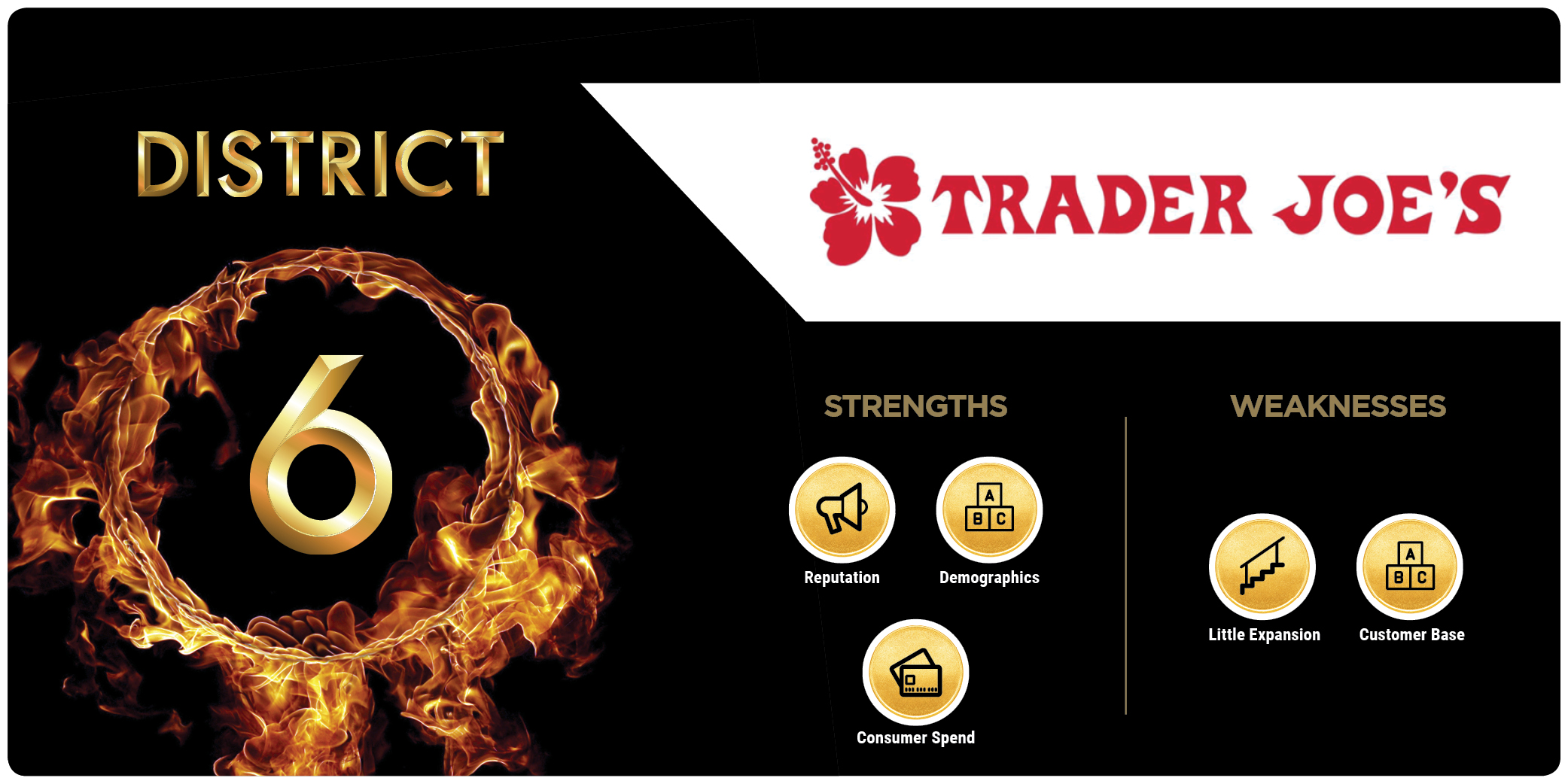
Strengths
- Consumer demographics: The typical Trader Joe’s consumer skews younger and more affluent than the average grocery shopper, and tends to build much larger baskets.
- Consumer spend: Trader Joe’s boasts sales per square foot of $1,723 — more than triple the grocery store average of $521, according to Packaged Facts estimates.
- Reputation: Trader Joe’s has no loyalty program, offers no coupons, does not advertise on television and has a rather limited social media presence – it relies on the extremely positive word of mouth it receives. According to the Forrester CX Index, 87 percent of Trader Joe’s customers report easy shopping experiences, and the store received 69 positive reviews for every single negative review received from consumers.
Secret Weapon
- Private-label brands: Unlike Aldi, Trader Joe’s signature innovation is the utter absence of national name brands on its shelves, instead choosing to rise and fall on the draw of its private-label brands alone. And that draw is strong. The brands’ famous “Two Buck Chuck” wine (which these days is actually four buck chuck) has sold around one billion bottles since it launched in 2002.
Weaknesses
- Very little multi-channel expansion: Trader Joe’s has no curbside pick-up program, and as of now seems to have no plans to even pilot one. Grocery delivery is available, but only through third-party services.
- Amazon/Whole Foods eating its customer base: As it turns out, Whole Foods Market’s younger, more affluent customers are also more likely than average to be Prime members – and Whole Foods has successfully used that fact to draw Trader Joe’s customers away, according to data by Sense360. The change wasn’t huge — Whole Foods went from grabbing 51 to 53 percent of customers in areas where the retailer went head-to-head with Trader Joe’s – but even small losses count in the grocery Hunger Games, particularly for Trader Joe’s, who relies on a small but loyal customer base to come in and spend a lot.
District 7: Wegmans
The smallest player in the game, and the most regional of chains, Wegmans makes the big board because of the extreme enthusiasm it consistently scores among consumers for its shopping experience. Although it’s a small brand, it’s one that punches far above its weight when it comes to reputation.

Strengths
- Reputation for product quality: Consistently ranked as a top performer for meat and produce quality by U.S. News and World Report, Wegmans also draws strength for its highly rated private-label brands, which are ranked as on par with Trader Joe’s.
- Outside-the-box application of mobile technology: Wegmans is the first supermarket chain in the U.S. to offer free access to Aira, a mobile and wearables app built to assist low-vision or blind customers. In-store, the app enables blind shoppers to connect to a remote sighted agent who can help the shopper navigate the store, find specific items and identify the shortest checkout line via live camera stream, GPS, maps and information sourced from the web.
Secret Weapon
- Fanatically loyal customer base: Wegmans (in a tie with Publix) is the American supermarket brand with the highest loyalty score, according to Market Force Information. The Harris Poll found that it is America’s second-favorite large retailer (Amazon edged it out by a single point). According to Engagement Labs, which measures consumers’ response to brands across social media, 90 percent of consumer interactions about the brand are positive, while only 6 percent are negative.
Weaknesses
- Tiny size: Wegmans is a regional brand, and a small one at that, with only 97 stores in six states. Growth is on the schedule, but they have a lot of growing to do, however beloved they are of their shoppers.
- Provisional progress with digital delivery: While Wegmans does offer grocery delivery and curbside pick-up at an increasing number of its stores, both programs are handled via a partnership with Instacart.
District 8: Albertsons
With more than thousands of stores divided up over a dozen different grocery chains, Albertsons Companies represent the second-largest grocery business in North America after Kroger. Albertsons is the parent brand behind Acme, Albertsons, Amigos, Carrs, Haggen, Jewel Osco, Lucky, Pavilions, Randalls, Safeway, Shaw’s and Star Market, Tom Thumb, United Supermarkets and Vons.
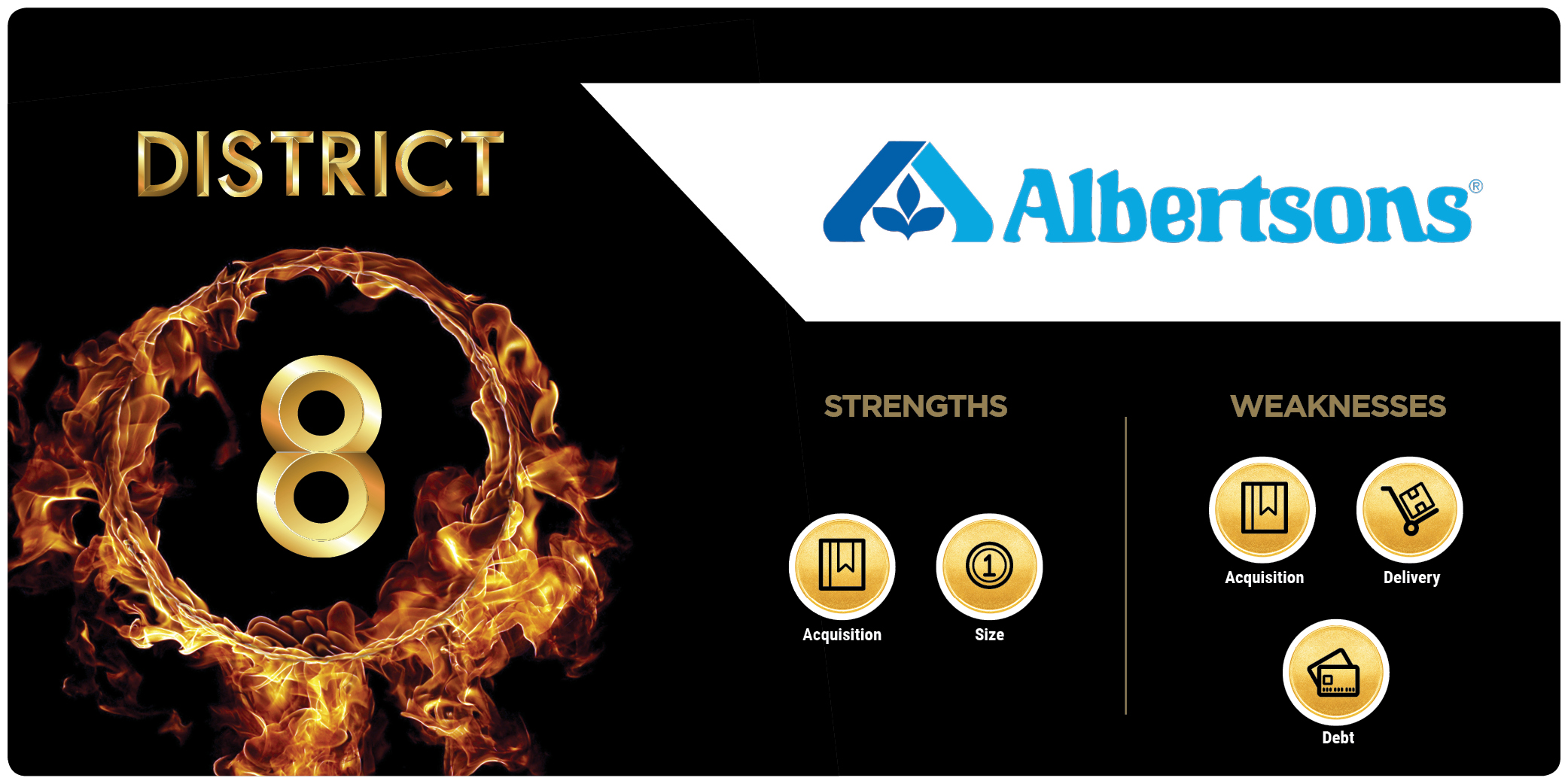
Strengths
- Size: There are over 2,300 Albertsons-owned stores in the U.S. – with locations in 38 states. The chain boasts 34 million weekly customers.
- Plated Acquisition: The grocery chain was in early on the migration of meal kits from digital subscription to grocery store shelves, and acquired meal kit Plated about a year ago.
Secret Weapon
- Albertsons/Greycroft grocery investment fund: This fund is expected to reach up to $50 million over time to invest in and develop grocery-related tech innovators. Greycroft was chosen for its expertise and connections with the early-stage tech industry. “As we saw with our recent acquisition of Plated, Albertsons Companies has the capital, scale and expertise to power future growth of the most promising emerging businesses and technologies across the food and grocery space,” noted Albertsons’ chief marketing and merchandising officer, Shane Sampson.
Weaknesses
- Failed Rite-Aid acquisition: Despite many months’ effort to merge the retail chain with the pharmacy chain, the deal ultimately fell apart a day before Rite-Aid’s board could vote when the two sides could not settle on final terms.
- Debt: Albertsons currently is carrying $12 billion in debt leftover from its 2005 merger with Safeway.
- Limited digital delivery progress: Though it has a delivery partnership with Instacart, the grocer has no curbside pick-up option under development, and its efforts are far behind other grocery players of its size.
District 9: Kroger
The second largest grocery seller in the U.S. after Walmart, Kroger is the country’s largest grocery chain. It is the firm behind several grocery and general merchandise brands, including Dillons, Baker’s Supermarkets, Gerbes Super Markets, Fred Meyer, Fry’s Food & Drug, Harris Teeter, King Soopers, City Market, Kroger, Divisions, JayC, QFC, Ralphs, Roundy’s, Copps, Metro Market, Mariano’s, Pick ‘n Save, Smith’s, Main & Vine, Food 4 Less, Foods Co. and Ruler Foods.
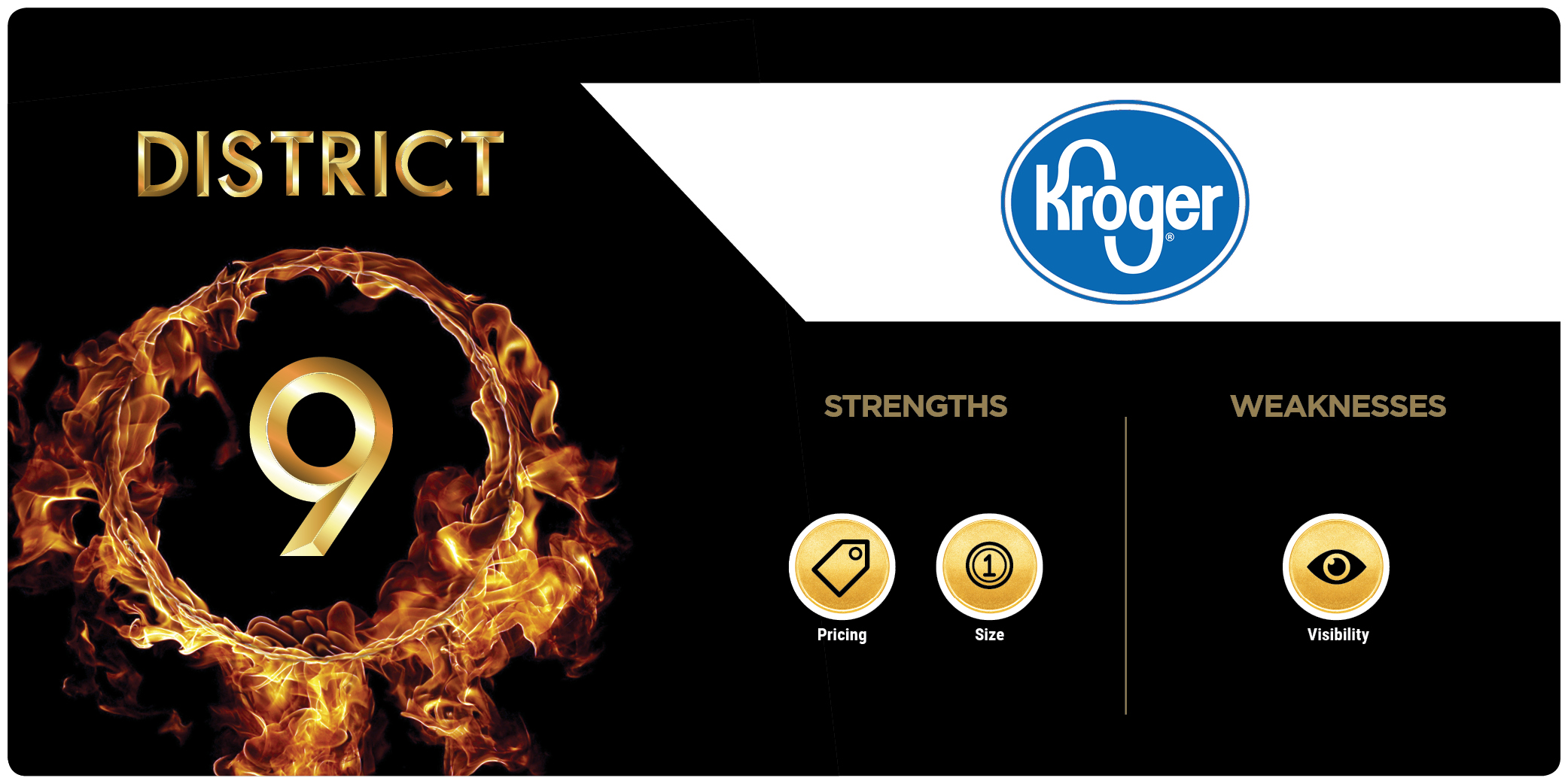
Strengths
- Size: There are around 2,800 Kroger locations in the U.S., it is the second-largest general merchandise retailer in the U.S. by sales (after Walmart), and the third largest retailer on the planet, with $115 billion in annual sales.
- Pricing Power: The store’s massive price cutting spree on 3,000 products hurt it with shareholders, as its stock price dropped 12 percent – but that did force other retailers, notably Walmart and Target, to follow suit.
Secret Weapon
- Rapid expansion of digital programs: Although Kroger started somewhat behind on digital expansion 18 months ago, the last year has seen it rapidly increase its focus and pick up the pace. In recent months, it increased its stake in British online supermarket Ocado for automated warehouses; took over meal kit company Home Chef; partnered with tech startup Nuro for driverless delivery pilots; expanded its own pickup service, ClickList; and rolled out Ship, its delivery service for dry goods. Kroger currently has 1,250 curbside pickup stores, with an eye to hit 1,800 by the end of 2018, and offers delivery from 1,200 through partnerships with Instacart and other third parties. As of its last earnings report, Kroger reported its online sales are up 64 percent year-on-year.
Weakness:
- Invisible to customers: Because Kroger is split up over so many brands and grocery chains, it’s mostly invisible to consumers, which has proven to be a challenge as Kroger has moved to expand its private-label brand offerings.
District 10: Publix
Florida-based and employee-owned, Publix is another smaller regional grocery chain that excels in its reputation for quality and a loyal customer base.
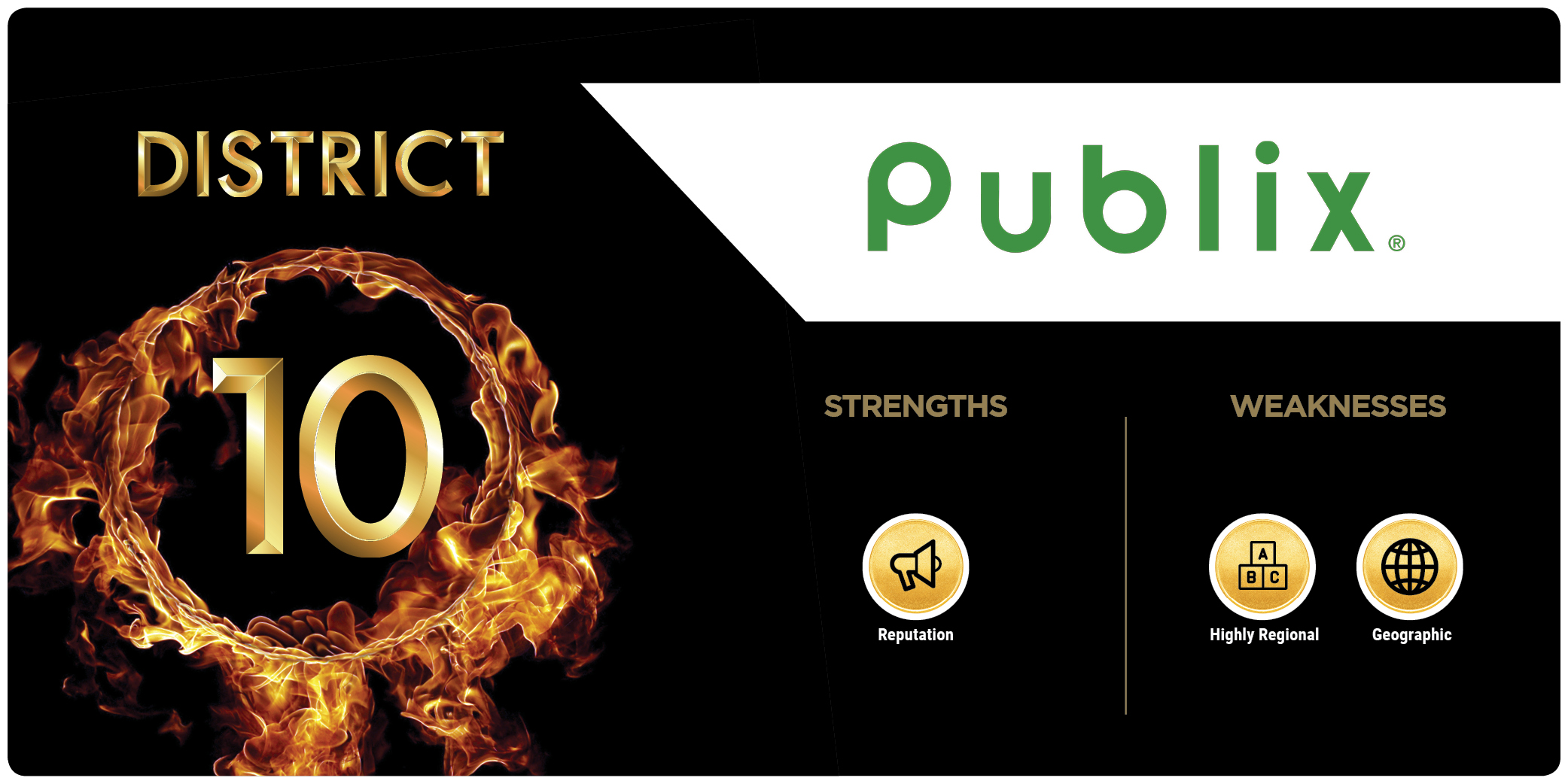
Strengths:
- Reputation: Publix tied with Wegmans in its Number One spot in the Market Force Customer Loyalty Index earlier this year. The same survey noted that Publix led the pack for store cleanliness, layout and selection of products.
Secret Weapons:
- Small but dense: Though Publix stores are only found in six states in the Southeastern United States – Florida, Georgia, Alabama, Tennessee, South Carolina, North Carolina and Virginia – it operates a fairly large network of densely packed stores, with just over 1,100 locations. Publix is so dominant in Florida that Albertsons tried and failed to directly challenge them in the state, lost and ended up selling all its Safeway locations in Florida to Publix while it retreated. Kroger has as of yet never directly challenged Publix in Florida.
Weaknesses
- Highly Regional: Well-known in the south – and literally unbeatable so far in Florida – Publix is virtually unknown outside its home region.
- Kroger (and everyone else) is eyeing their turf: Despite having pulled out of Florida in 1988, Kroger is dipping a toe back in with the construction of a 74,000-square-foot supermarket launched under its Lucky’s brand name in Palm Beach. Speaking of Palm Beach, Amazon just expanded its two-hour free grocery delivery in that market in the summer of 2018.
District 11: Lidl
Another international brand on the list, Germany-based Lidl first made its way to U.S. shores in 2017 with a large and well-developed international fanbase. Overall, Lidl operates over 10,000 locations in 28 European countries. Its entrance to the U.S., however, has been a bit rocky.
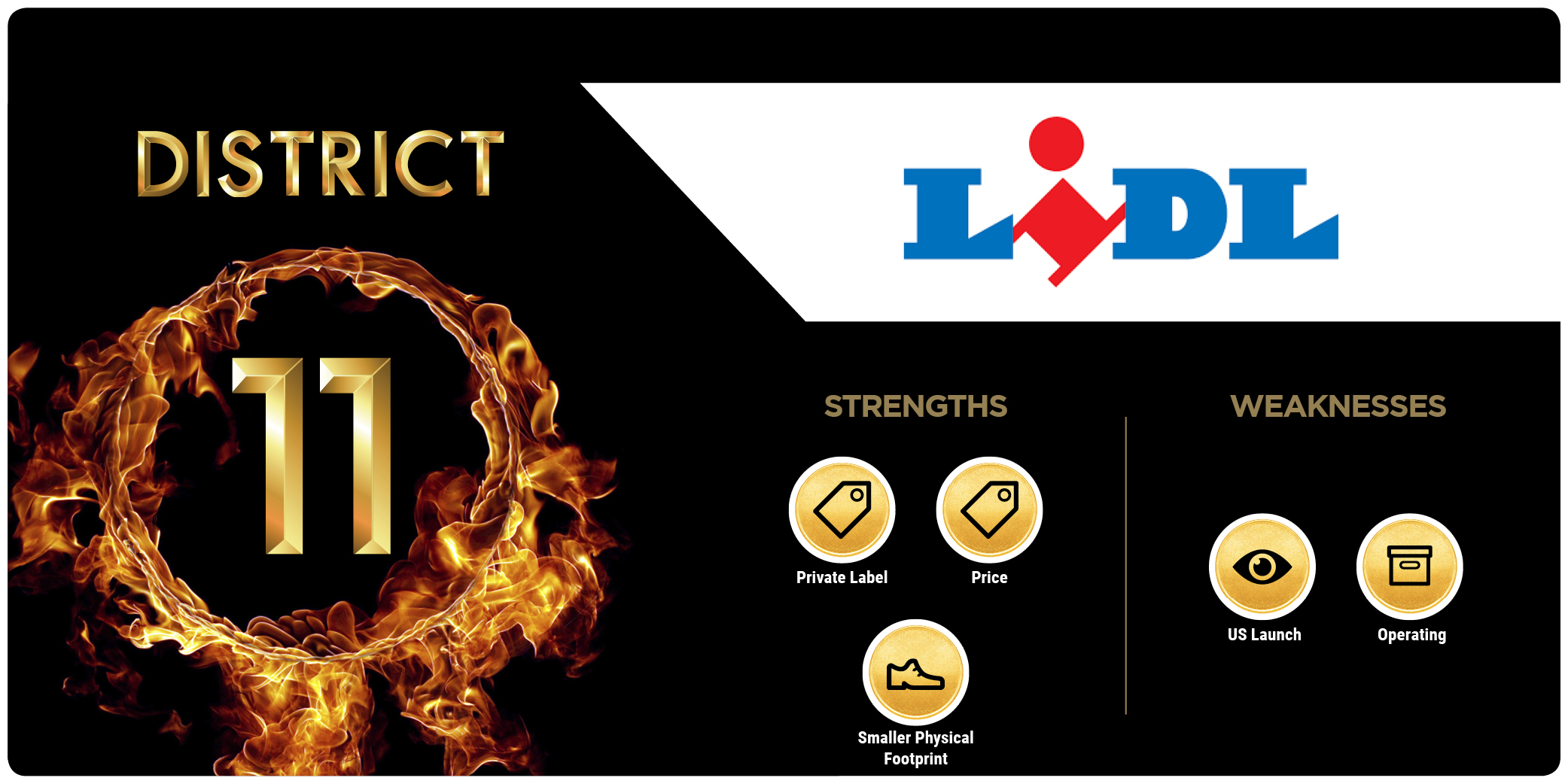
Strengths:
- Price: Like its main global competitor, Aldi, Lidl distinguishes itself with pricing conspicuously lower than other grocery players.
- Private-label brands: Though Lidl does carry some national brands in its stores, 90 percent of the goods it sells are from its own private label.
- Smaller store footprint: The average size of a U.S. Lidl is 21,000 square feet, roughly one third of the size of an average U.S. grocery store.
Secret Weapons:
- Fresh goods quality: Though Lidl is a discount grocer, it draws high customer reviews and marks for the quality of its meats and fresh produce. Also particularly lauded is its selection of cheap, award-winning wines.
- Lidl specials: Apart from their regular grocery offerings, Lidl also famously offers flash sales on a wide variety of unexpected goods Monday and Thursday. Past entrants have included $9 leather wallets, $12 chest waders and $20 charcoal grills.
Weaknesses:
- Extremely rocky U.S. Launch: When Lidl announced its expansion into the U.S., its stated intention was to open 100 stores by the summer of 2018. As of the summer of 2018, Lidl had opened 53 U.S. locations and its expansion efforts had mostly stalled.
- Operating outside its comfort zone: The average Lidl in the U.S. is around 20,000 feet, small for a U.S. grocer, but twice the size of an average European Lidl’s 10,000 square feet. Similarly, a U.S. Lidl stocks 4,000 goods, quintupling the 1,000 to 1,500 goods an average European Lidl market stocks.
District 12: The A&P
In the Hunger Games, District 13 never participated, as it was destroyed before the competition ever began. It’s a fitting analogy for A&P, a firm that more or less invented the modern grocery store, but didn’t live to see the grocery Hunger Games.
We decided in the spirit of District 13 that we would give a shout out to A&P, which, like District 13 in the Hunger Games, is this story’s cautionary tale.
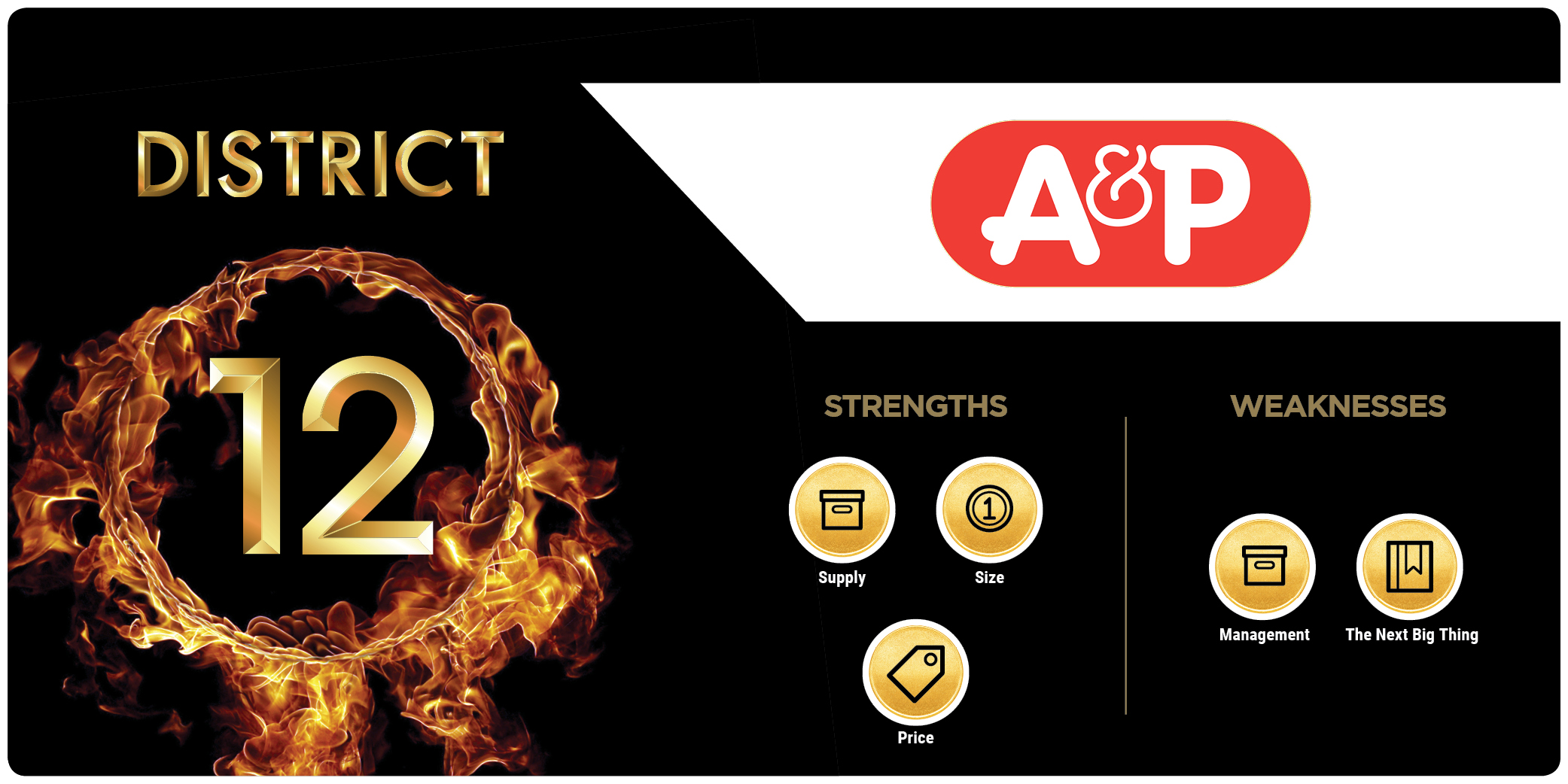
Strengths:
- Price: Using advanced supply chain methods, the ability to negotiate directly with suppliers and a stable of private-label brands, A&P was successfully able to lower their prices below their small grocery competitors, so much that the Supreme Court found their innovations to be anti-competitive.
- Supply: As opposed to the old norm of visiting several different shops for all household needs – the butcher, the baker, the candlestick maker – A&P in the 1850s began developing a model that consolidated that experience into a single shop, with hundreds and then thousands of goods on offer.
- Size: As of 1929, A&P operated 16,000 locations in all but nine states in the U.S. and reached $1 billion in sales in 1929. Its sales were twice that of any other retailer. The chain reportedly sold one-tenth of all the sugar in the U.S., one-eighth of all coffee and more butter and cigarettes than any other retailer. Of the 32 million households in the U.S. at that time, it was reported that 5 million walked into one of its stores every day.
Secret Weapon:
- Data: A&P’s founders, George and John Hartford, were obsessed with data about 175 years before it was cool, using it to optimize their supply chain, stock their shelves, develop private-label products and negotiate with suppliers.
Fatal Flaws:
- New management, new approach: A&P was the largest retailer in the U.S. until 1975, but its margins were always low. When the antitrust decision came down in 1949, A&P’s margins were 1.3 percent compared to 2.1 to 2.7 percent for most retailers, due to its commitment to lower prices to drive sales. After the Hartford brothers’ deaths, new management decided to move away from that lower price focus to chase higher margins.
- The next big thing: At the same time that A&P was chasing new things, a next big thing emerged: Supercenters like Walmart and Target, which stocked groceries with a wider array of consumer goods. A&P couldn’t keep up. By 2009, it was a regional chain, and by 2015 it was no more.
“The Hunger Games,” the novel, is an underdog story at base – it’s the story of how the plucky little upstart from District 11 overcomes the tributes from the bigger, richer and more prepared districts, and of a government that is eventually plotting against her to win the Hunger Games.
And in the grocery version of the Games? Well, while we won’t say it is impossible that one of the plucky little upstarts will somehow overthrow the bigger players at Amazon, Walmart and Kroger to win the whole event, it is highly unlikely.
But then, about a year ago, Amazon was considered a plucky upstart. It had many of the advantages that it has today, and many of the same secret weapons, but it didn’t have a physical hub in the form of Whole Foods – and while many analysts thought they would be a competitor, only very few predicted they would be the player to beat in the field.
A year – and a very strategic acquisition – can make a big difference in how any player’s fortunes are evaluated.
And, of course, the grocery Hunger Games aren’t quite the same zero sum battle to the death as the literary version. There will not be one tribute standing at the end of all this – consumers have different preferences and different players on the field, providing better and worse for them.
But will there be quite as many districts as there are today? Probably not. And, just looking at the rankings in the data, some of those players – even some of the big ones – are looking heavy on weaknesses and light on secret weapons. The battle might be uphill, and could eventually be for survival.
As Effie Trinket (a prominent character in the series) was fond of saying: “May the odds ever be in their favor.”
